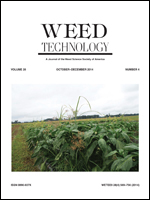Dinitroaniline and amide herbicides have been continually applied in garlic in China, leading to the change of weed community and dominant weed species. Catchweed bedstraw, shepherd's-purse, and flixweed have become major troublesome weeds. Crop safety of fluorochloridone to 18 crops (at rates of 500 and 1,000 g ai ha−1) and weed efficacy against 35 weeds (at rates of 125 and 250 g ha−1) were determined in greenhouse studies. Visual estimate indicated that fluorochloridone was not safe to many crops, especially cruciferous crops. Among all of the trial crops, garlic was the only crop which was not injured in both PRE and POST application at rate of 500 g ha−1, even when treated with 1,000 g ha−1. Fluorochloridone showed high efficacy against most weeds tested in this experiment when applied PRE, but could not offer a satisfactory control when applied POST. Further rate-response study of fluorochloridone to garlic and six weeds was also investigated. PRE application of fluorochloridone to garlic was safer than POST, and the rates for 10% growth reductions (GR10s) were 1,959 g ha−1 for PRE and 537 g ha−1 for POST. When applied PRE, GR90s of shepherd's-purse and flixweed were 19.2 and 70.3 g ha−1, respectively. Though GR90 of catchweed bedstraw was 541 g ha−1, it could be totally controlled without injuring garlic. On the basis of these results, fluorochloridone has an excellent prospect for weed control in garlic fields.
Nomenclature: Fluorochloridone; catchweed bedstraw, Galium aparine L.; flixweed, Descurainia sophia (L.) Webb. Ex Prantl; shepherd's-purse, Capsella bursa-pastoris (L.) Medik; garlic, Allium sativum L.
Los herbicidas dinitrioaniline y amide han sido aplicados continuamente en ajo en China, lo que ha llevado a cambios en la comunidad de malezas y las especies de malezas dominantes. Galium aparine, Capsella bursa-pastoris y Descurainia sophia se han convertido en las mayores malezas problemáticas. En estudios de invernadero, se determinó la seguridad para 18 cultivos de fluorochloridone (a dosis de 500 y 1,000 g ai ha−1) y su eficacia para el control de 35 especies de malezas (a dosis de 125 y 250 g ha−1). Estimados visuales indicaron que fluorochloridone no fue seguro en muchos cultivos, especialmente especies crucíferas. Entre todos los cultivos del estudio, el ajo fue el único cultivo que no fue dañado en aplicaciones PRE y POST con la dosis de 500 g ha−1, e inclusive cuando se trató con 1,000 g ha−1. Fluorochloridone mostró alta eficacia de control en la mayoría de las malezas evaluadas en este experimento cuando se aplicó PRE, pero no pudo ofrecer un control satisfactorio cuando se aplicó POST. También se investigó la respuesta a dosis de fluorochloridone de ajo y seis malezas. La aplicación PRE de fluorochloridone a ajo fue más segura que la POST, y las dosis que causaron reducciones del crecimiento de 10% (GR10s) fueron 1,959 g ha−1 para PRE y 537 g ha−1 para POST. Cuando se aplicó PRE, GR90s de C. bursa-pastoris y D. sophia fueron 19.2 y 70.3 g ha−1, respectivamente. Aunque GR90 para G. aparine fue 541 g ha−1, esta maleza se puedo controlar totalmente sin dañar al ajo. Con base en estos resultados, fluorochloridone tiene un excelente potencial para el control de malezas en campos de ajo.





